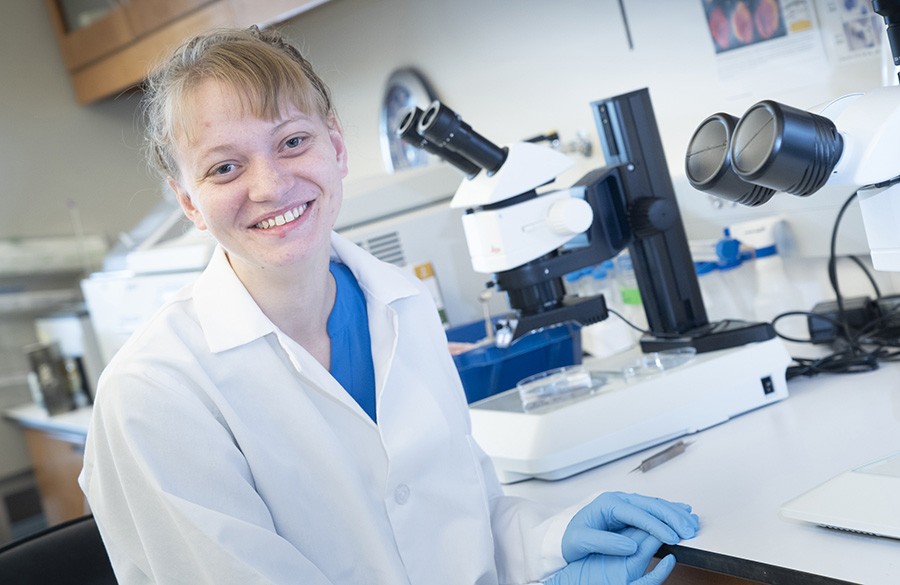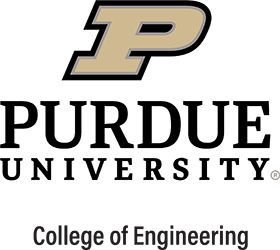MD/PhD Student's Lab Insights Foresee Kidney Patients' Lifetime Gains
Sarah Lipp's big-picture research agenda combines a chemical engineer’s interest in the separation capabilities of the human kidney and a molecular biologist's interest in cellular abnormalities threatening the organ. She envisions another combination-resources for Ph.D. candidates at Purdue University's Weldon School of Biomedical Engineering and for students of Indiana University School of Medicine-leading to dynamic techniques that can help renal disease patients retain their vital filtration functions.

While beginning her studies at IU School of Medicine, Lipp learned the two schools' partnership in the Medical Scientist Training Program (MSTP) offered the flexibility to pave the interdisciplinary path toward her goal. Now entering her second year as a graduate student working in a Weldon School lab in West Lafayette, she is using her Leslie Bottorff Fellowship to pursue the MD/PhD skillsets to characterize tissue changes that can help make the vision a reality.
"The Bottorff Fellowship helps students collaborate," says Lipp. That is reflected in garnering clinical experience during her graduate research phase. Given her stated interest in the broad "context" of patient care, she is building upon her undergraduate double majors in chemical engineering and cell and molecular biology, observation of pediatric nephrologists (kidney specialists), as well as a clerkship in surgery.
She works in Weldon School's Musculoskeletal Extracellular Matrix Laboratory under the direction of principal mentor Sarah Calve, PhD. Biomedical engineer Dr. Calve and her team probe the influence of extracellular matrix (ECM) remodeling during musculoskeletal regeneration and tissue repair.
Lipp, working with mice, aims to quantify changes in ECM-a complex network of proteins-during all phases of obstructive nephropathy, which causes end-stage renal disease. Details of the protein changes could aid tissue engineers in restoring kidney function.
In light of clinical experience she is gaining at Riley Hospital for Children at Indiana University Health in Indianapolis, Lipp particularly wants to study developmental ECM changes. This information would aid regenerative medicine techniques, applied over time. Her clinical IU School of Medicine mentors are Dr. David Hains, MD, and Dr. Andrew Schwaderer, MD, both pediatric nephrologists.
Travel to clinical experiences at Riley and other medical facilities constitutes one of the costs covered by the Bottorff Fellowship. Lipp says she enjoys working directly with patients and gaining insight into different manifestations of kidney injury. The financial support allowed her to attend a workshop that shed light on the pathophysiology of different kidney injuries using mouse models. Attending the American Society of Nephrology "kidney week" sessions will help her to connect research and clinical concepts to make her a better physician-scientist.
Lipp’s Ph.D.-related learning will be followed in early 2022 by a return to student life at the IU School of Medicine, followed by medical residency. She anticipates using her combined MD/PhD for a career that continues to mix the clinic, research lab, and classroom.
"My long-term goal is to be a medical school faculty member whose clinical observations motivate lab research," Lipp said.
She is already comfortable with a multifaceted life tapping the best of the two schools and two cities of the MSTP partnership. As a co-chair of Students for the Prevention of Kidney Disease, she helps coordinate medical student involvement in kidney screenings for the public, and she volunteers at the IU School of Medicine Student Outreach Clinic in Indianapolis.
There's also time for personal restoration through her love of the arts. Lipp continues classical ballet classes she has taken since 2002. She appeared in IU School of Medicine's "Medical School Musical" in 2018. The combined timeline, spanning eight years of diverse experiences in the MSTP in light of a wide-ranging plan for the future, affirms an overarching theme of purposeful collaboration and curiosity.
Her concern for the whole patient, both child and adult, aligns with a concern for the whole structure of care—promising no quick fixes but bringing engineering and medicine to bear for ongoing cooperation with tissue engineers, clinical practitioners, and the originators of life-saving research.


